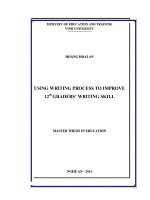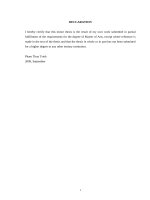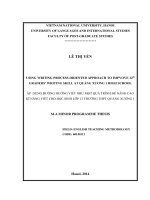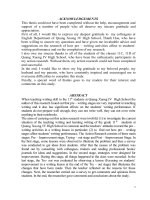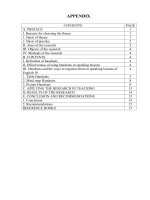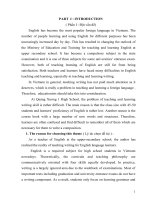Using writing process oriented approach to improve 12th graders’ writing skill at quang xuong i high school
Bạn đang xem bản rút gọn của tài liệu. Xem và tải ngay bản đầy đủ của tài liệu tại đây (136.42 KB, 18 trang )
PART I : INTRODUCTION
( Phần I : Đặt vấn đề)
English has become the most popular foreign language in Vietnam. The
number of people learning and using English for different purposes has been
unceasingly increased day by day. This has resulted in changing the outlook of
the Ministry of Education and Training for teaching and learning English at
upper secondary school. It has become a compulsory subject in the state
examination and it is one of three subjects for some universities’ entrance exam.
However, both of teaching learning of English are still far from being
satisfaction. Both teachers and learners have faced many difficulties in English
teaching and learning, especially in teaching and learning writing.
In Vietnam in general, teaching writing has not paid much attention as it
deserves, which is really a problem in teaching and learning a foreign language .
Therefore, educationists should take this into consideration.
At Quảng Xương 1 High School, the problem of teaching and learning
writing skill is rather difficult. The main reason is that the class size with 45-50
students and learners’ proficiency of English is rather low. Another reason is the
course book with a large number of new words and structures. Therefore,
learners are often confused and find difficult to remember all of them which are
necessary for them to write a composition.
1. The reason for choosing this theme ( Lý do chọn đề tài ) :
As a teacher of English at the upper-secondary school, the author has
realized the reality of teaching writing for English language learners.
English is a required subject for high school students in Vietnam
nowadays.
Theoretically,
the
curricula
and
teaching
philosophy
are
communicatively oriented with four skills equally developed. In practice,
writing is a largely ignored area due to the washback of examinations. Most of
important tests including graduation and university entrance exams do not have
a writing component. As a result, students only focus on learning grammar and
1
vocabulary. They have considerable difficulty in learning the writing skill.
Writing was traditionally considered as a product, which means that
students write a composition and the teacher provides comments and gives
correction and the students do not have to rewrite the draft. The present trend
regards writing as a process. That is, students write multiple drafts before the
completing final draft. The ability to write well is not a naturally acquired skill;
it must be practiced and learned through experience. Writing is a complex
combination of skills that is best taught by breaking down the process. The
writing process involves a series of steps to follow in producing a finished piece
of writing. By breaking down writing step-by-step, the mystery is removed and
writer’s block is reduced. Most importantly, students discover the benefits of
constructive feedback on their writing, and they progressively master, and even
enjoy writing. Although this idea is not new in theory, how to apply it in practice
is not easy. Being a teacher of English at a secondary school, I see the reality of
teaching writing skill in my setting. I have, therefore, decided to conduct a study
on this area to improve the teaching practice in my school.
The study deals with the use of writing process to improve 12 th graders’
writing skill at Quang Xuong I high school. It focuses on the students’ revising
and editing the drafts after they receive feedback from teacher and the changes
made to each paper between first and final drafts. The text type was descriptive
text.
2. The aim of the theme (Mục đích của đề tài ):
The aims of the study are:
- To investigate the impact of process writing on 12th graders’ composition skill.
- To find out effective methods of teaching English writing skill to 12th graders
3. The scope of the theme ( Phạm vi của đề tài ):
The study is narrowed down to the area of teaching and learning writing for
grade 12 students at Quảng Xương 1 High School with the textbook English 12.
Specifically, this theme deals with the present situation in teaching and learning
2
writing skill. Accordingly, the study deals with the use of writing process to
improve 12th graders’ writing skill at Quang Xuong I high school.
The study focuses on the students’ revising and editing the drafts after
they receive feedback from teacher and the changes made to each paper between
first and final drafts. The text type was descriptive text.
4. The method of the study ( Phương pháp nghiên cứu ) :
The study employs a combination of qualitative and quantitative methods.
It involves the analysis of students’ writing, interviews, reflexive journals, and
statistical data. Multiple drafts approach is used for error treatment and content
development. Interviews and reflective journals provide in-depth information
that supplements the analysis of writing drafts.
3
PART II : DEVELOPMENT
( Phần II: Giải quyết vấn đề )
1. Reasoning basis (Cơ sở lý luận ):
Nowadays, Vietnam opened its doors to the world, beginning a new period
of scientific, educational and commercial cooperation with many countries.
English has become an essential means for Vietnamese people to enter into
international communication. In this context, new approaches and methods of
language teaching have been introduced and considered by a large number of
Vietnamese teachers and educators .
In an attempt to innovate Vietnamese education to meet the demand of the
society in the progress of integration and development, the Vietnamese Ministry
of Education and Training has reformed English textbooks concentrating on four
skills: reading, speaking, listening, and writing. Of the four skills, many teachers
and students alike consider writing to be most difficult and complicated to teach
and to learn. In fact, there are a variety of reasons for this problem, and therefore
finding appropriate techniques and methods for teaching writing effectively to
students requires long serious research.
2. The actual subject before applying new methods to teaching:
(Thực trạng của vấn đề trước khi áp dụng sáng kiến kinh nghiệm)
At Quảng Xương 1 High School, the problem of teaching and learning writing
is rather difficult. There are 36 classes in this school. The class size is generally
large with 40-45 learners in one. The classroom are equipped only with a chalk
board and desks for four students sharing one. Moreover, some of the teachers of
English at Quảng Xương 1 High School find it difficult to teach writing
successfully because of the students’ language level. Furthermore, the majority of
the teachers were trained under the strong influence of the Grammar-Translation
method, which impedes them from teaching writing successfully .
Besides,the introduction of the new textbook “English 12” in 2006 has
marked real renovation in language teaching and learning from the traditional
4
approach-grammar translation method. Writing is the last skill in each unit. It is
presented after three skills of reading, speaking and listening. These skills help
prepare vocabulary, sentence structures and ideas for writing tasks.Writing skill
on different kinds of texts such as: writing a letter of request, writing a report,
describing a book, etc. helps students practice writing with real-life situations on
text. However , students are still fed up with writing because nowadays all
English tests they have to do at exams are multiple-choice tests. They have not
been aware of the fact that writing is also an effective way to pracice English
grammatical structures and new words, which helps them to do the tests better.
The results of my students’writing in Unit 10 , English 12, part D ( Writing) in 12T1
and 12C3 before applying the new method:
Class
Results
Mark 9-10
Mark 7-8
Mark 5-6
Mark <5
12T1 (45students)
1
8
27
9
12C3(42 students)
0
3
25
14
In search of documents for the study, I have not found any research on the
application of process writing at high school in my region. This is the reason
why I have decided to study it in Quang Xuong I high school where I am
currently teaching.
3. Applied methods for solution (Giải pháp):
Writing is one of the four skills in language acquisition. However, teaching
and learning how to write is a complicated and laborious process. For every
language learner it is essential to acquire the language components of a language
before developing the language skills. Therefore, it can not be denied the role of
writing in language teaching and learning is extremely significant.
Therefore, the teacher’s task is to instruct students how to write a
composition successfully and in this case, motivation is an important factor that
decides the success of learning, which means the teachers have to search for and
apply effective ways to motivate their students to learn writing skill.
5
3.1. Principles of teaching writing :
Teaching how to write effectively is one of the crucial life-long skills that
instructors impart to their students. It is a matter of prescribing a set of
predetermined tasks or exercises to the students. When teaching a writing
course, instructors not only teach about how to develop ideas in writing, but also
pay proper attention to how to write English sentences grammatically and
systematically. The effectiveness of writing instruction depends on both teaching
compositions and assessment.
3.2. What are the methods of teaching writing?
Various methods of teaching composition have been employed in
language teaching. They can be categorized into two major approaches, namely
the process and the product approach.
3.2.1. The product approach
The product approach aims at making the students competent in the
language when they write relevant and coherent pieces of writing. It focuses on
the final product of the writers and the texts written by the students are based on
models provided by the teacher.
3.2.2. The process approach
Writing in process approaches is seen as predominantly to do with
linguistic skills, such as planning and drafting, and there is much less emphasis
on linguistic knowledge, such as knowledge about grammar and text structure.
There are different views on the stages that writers go through in producing a
piece of writing, but a typical model identifies four stages: prewriting;
composing/drafting; revising; and editing (Tribble 1996: 39) [4]. This is a
cyclical process in which writers may return to pre-writing activities, for
example, after doing some editing or revising. A typical prewriting activity in
the process approach would be for learners to brainstorm on the topic of houses.
3.3. The process of writing:
Of the two methods metioned, the process of writing is known as the
6
better. The process of writing comes through several stages before reaching the
final draft. It is a process that involves six distinct steps: prewriting, drafting,
responding, revising, editing and publishing.
Stages in Writing Process (Hyland, 2003) [3]
3.3.1. Prewriting
In this stage, students involve the activities such as reading,
brainstorming,
mind
mapping,
discussing,
fast
writing,
questioning,
interviewing, which encourage them to generate ideas before they write their
sentences in the first draft. Then, students try to order their data and arrange
them according to their priorities that mean which idea is going to be the first,
which is the second, and so on.
The prewriting stage is divided into three steps. The first step is to put the
ideas into subsists according to the main idea and eliminate all the irrelevant
ones. The second step relies on putting a topic sentence to each of the subsists
made in the first step and the topic sentence must reflect the whole subsist, that
is when the reader reads the topic sentence, he can infer what is coming. The last
step in the first stage is to order the subsists according to what the writer thinks
is appropriate to be the first, second and so on.
For example:
7
In Unit 14: International organizations, English12. Period: 86
“Suppose you were offered a job with one of the international organizations,
which one would you like to choose? Write a paragraph of about 120-150
words expressing the reasons why you choose the organization”.
Students in 12T1 has brainstormed and ordered their ideas:
WWF- Reasons:
*love animals wild and plants.
I really love animals wild and plants.
*be good research.(omitted)
*have opportunity to live abroad.
I have opportunity to live abroad.
* have chance to travel the world
I will have chance to travel the world
3.3.2. Drafting
Drafting is to start writing according to the ideas planned before. The
result of brainstorming session provides a plan of description of topic. Oshima
and Hogue (2002; 28) [1] call this stage as writing and revising drafts. They
argue that no piece of writing is perfect the first time and the writer has to write
and revise several drafts until he/she produces the final draft. In the first step, the
composition might be written without considering to grammar, punctuation, or
spelling and no importance to the structure. Students may add new information
in the drafting stage; there is no matter to hesitate because the focus is on ideas,
purpose, coherence and relevance, unity, sufficient supporting ideas and
concluding sentences. As a last step in the drafting stage, the student checks the
grammar, spelling and punctuation mistakes.
For example:
Suppose I were offered a job with one of the international organizations, I
like to work for WWF for an amount of reason. I really love animals wild and
plants. plants rare and animals also good research. It make me better biology.
8
On the other hand, I have opportunity to live abroad. I can use English at work
and return high salary. I will have chance to travel the world, meet people and
works at remote and mountain .Finally, I can protect dangerous species, which I
love the most (added information). That’s why WWF is the best suitable fun for
me .
3.3.3. Reviewing/Revising
Revising is the stage where the writer comes through his/her final draft
and tries to define the different lapses and corrects them in a second draft. All
good writers go through several steps of the revision because they want to make
their writing the best it can. At this point, they consider what they have written,
get feedback from others, and then make changes. They can scratch out
unnecessary or irrelevant information, squeeze ideas that they want to add into
the margin, and even cut up and re-paste the paper to change the order or make
addition. According to Oshima and Hogue (2002; 29) [1], during the first
revision we should concern mainly with content and organization. This is how to
proceed:
Read over the paragraph carefully for a general overview. Focus on the
general aspects of the paper and make notes in the margin.
Check to see that you have achieved your stated
purpose. Check for general logic and coherence.
Check to make sure that the paragraph has a topic and that the topic
sentence has a central (main) focus.
Check for unity. Cross any sentence that does not support the topic
sentence.
Check to make sure that the topic sentence is developed with sufficient
supporting details. Be certain that each paragraph gives the readers enough
information to understand the main idea.
Check the use of transitional signals.
Finally, does your paragraph have or need a concluding sentence? If
9
you wrote a final comment, is it on the topic?
The next revision is to check for grammar, sentence structure, spelling,
and punctuation. This checking is specific as following: (Oshima and Hogue,
ibid.)[1].
Check over each sentence for correctness and completeness: no
fragments and no choppy or run-on sentences.
Check over each sentence for a subject and a verb, subject- verb
agreement, correct tenses, etc.
Check the mechanics: punctuation, spelling, capitalization, tying errors,
etc.
Change vocabulary words as necessary.
In this stage, the students review a draft to check errors based on the
feedback from himself or herself and teacher or peers. The writers need to make
changes to another draft before having someone else read it and offer further
feedback and suggestions. Thus, drafting and revising could theoretically be
completed and repeated indefinitely.
For example:
Teacher’s comments:
You had many good ideas in the paragraph. To make your writing better,
consider the following suggestions:
- Your writing is under length. Add some more ideas to make it least 120 words
- Do not copy the question, use your own words by paraphrasing it.
- Use more linking words to connect your ideas.
Student’s writing:
Everyone has his or her own choice. To me, suppose I was offered to work
for one of the international organizations, I’d like to work for WWF for an
amount of reasons. First, I really love animals wild and plants. I want to do
reseach on plants rare and animals. It will make me better at biology. Second, I
have ^. opportunity to live abroad. I can use English at work and may have ^
10
high salary. Third, I will have chance to travel all over the world, meet different
people and works in remote and mountain areas. Finally, I can protect
dangerous species, which I love the most. That’s why WWF is the best suitable
fun for me .
3.3.4. Editing
Editing is important step because it helps moving from the stage of
revising where there are many incomplete ideas, incorrect spelling and
unstructured sentences to the stage of correcting all the final draft. Once
revisions are made and changes to major traits of a writing project are complete,
editing must take place as “a diamond is polished after being shaped”. Whereas
revisions are easily guided by any peer reviewer, editing changes may require
the assistance of someone who is knowledgeable about grammar. This is where
the role of teacher in giving direct and indirect feedback will be applied.
According to Trimbur (1999: 680) [2], the reason that the writers must
learn to edit their work is not simply to avoid grammatical errors, misspellings,
and poor style as if writing were a matter of abiding by the law. There are two
further reasons for editing that are important to understand. The first reason is
that the correctness of writing influences readers. The sentence errors,
punctuation mistakes, misspelling words, and stylistic lapses can distract readers
and undermine a writer’s credibility. The second reason is that sentences are
basic units of meaning that express the relationship among ideas. Writers edit
their work not just to make sure the grammatical correctness of sentences but
also to clarify what they are trying to say. For these reasons, editing involves
working with sentences to make a piece of writing persuasive to readers.
For example:
Everyone has his or her own choice. To me, suppose I was offered to work
for one of the international organizations, I’d like to work for WWF for an
amount (WC) of reasons. First, I really love animals wild (WO) and plants. I
want to do reseach (SP) on plants rare (WO) and animals. It will make me
11
better at biology. Second, I have ^. opportunity to live abroad. I can use English
at work and may have ^ high salary. Third, I will have chance to travel all over
the world, meet different people and works (S-V A) in remote and mountain
(WF) areas. Finally, I can protect dangerous (WC) species, which I love the
most. That’s why WWF is the best suitable fun (WC) for me.
3.3.5. Publication
This stage takes place when a product of the writing process is shared
with its intended audience. Publication can occur in a variety of forums as well
as numerous times for a single product. The rewards of the writing process are
often revealed at the publication stage, when readers of a product express that
the purpose of a written project has been fulfilled. The writers realize the
payments of their hard work at the publication stage.
For example:
Everyone has his or her own choice. If I was offered to work for one of the
international organizations, I’d like to work for WWF for a number of reasons.
First, I really love wild animals and plants. I want to do research on rare plants
and animals to understand more about them. I will be better at biology. Second,
I have an opportunity to live abroad. I can use English at work and may have a
high salary. Third, I will have a chance to travel all over the world, meet
different people and work in remote and mountainous areas. If I work in these
environments, I can protect endangered species, which I love the most. That’s
why WWF is my first career choice (125 words).
Teacher’s comments:
You have made good progress. Your writing is now well written with
convincing ideas and coherent organization. I hope to see greater achievements
of yours.
4.Researched results: ( Kết quả đạt được ):
4.1.For myself as a teacher:
12
I have practiced teaching English writing skill in my classes .
The students were required to write three drafts on the topic: “Suppose
you were offered a job with one of the international organizations, which one
would you like to choose?” For the first draft, students wrote their first drafts
and then received teacher’s feedback on their writing in part of content and
organization aspect. Corrective feedback was not provided; however, if a
sentence was ambiguous, it would be pointed out so that the student knew what
part to rewrite. They rewrote the second drafts based on the teacher’s comments.
Besides content and vocabulary, the second drafts were provided with feedback
on vocabulary, language use and mechanics by the way of underlining the
errors, and correction symbols. Then the students wrote their final drafts with
reference to the teacher’s comments and suggestions. The findings of the study
indicate that taking part in the process of writing, students’ writing was
improved greatly in five aspects: content, organization, vocabulary, language
use, and mechanics. The errors were reduced significantly after each draft.
Based on teacher’s indirect feedback, students themselves could correct many
errors. The results are shown in the following tables:
Table 4.1.1: Errors in content and organization in 3 drafts
The 1st drafts
The 2nd drafts The 3rd drafts
Number of error
109
37
1
Percentage
67.7%
23%
0.6%
This table shows the students’ improvement in part of organization and
content. It clearly gives sample evidence that most students’ writing ability is
improved under the participation in the process of writing. For content and
organization, the errors in the first drafts account for 67.7% of the total errors.
Then they were greatly reduced to 37 errors or 23 % in draft 2. There was only 1
error or 0.6 % in the final draft. It can be concluded that the target has been
achieved, in this case the students already made good content and organization
of text in final drafts.
Table 4.1.2: Errors in vocabulary and language use of the students’ drafts
13
The 2nd drafts
The 3rd drafts
Total
Number of error
226
15
327
Percentage
69.1%
4.6%
100%
The table shows the students’ improvement in vocabulary and language
use aspect and it gives the strong impression that the process of writing can
improve their writing ability. From the table, it can be concluded that numbers of
errors decreased from 226 errors (69.1%) to 15 errors (4.6%) in draft 3. Students
did improvement in draft 2 and the final draft better than in draft 1.
Table 4.1.3: Mechanical errors in the students’ drafts
The 2nd drafts
The 3rd drafts
Total
Number of error
63
3
66
Percentage
95,4%
4,6
100%
As shown in the table, students made 63 errors in mechanics in the second
drafts. They were reduced to 3 errors in the final drafts. The results indicate that
the errors decreased considerably, showing students’ good progress.
Therefore, teaching writing as a process is very useful for me to
improve my students’writing skill.
4.2. For students:
In the first draft, many students had problems in expressing the ideas and
writing the content of the text. They also produced unorganized texts which are
irrelevant with what they wanted to write. The major problem is the use of
language and vocabulary, particularly the use of word form, word order, word
choice, preposition, article, verb, verb tense, conjunction etc. However, in the
second drafts, most students rewrote better compositions. The number of errors
decreased greatly in the third drafts. Students could correct most of the errors
that are pointed out by the teacher. It is noticeable that the writing process
involves students in the process of thinking and trying to find out the answers to
their problems because it helps them see what has been done and what has been
achieved during the process of writing.
The results of my students’writing in Unit 14 , English 12, part D
14
( Writing) in 12T1 and 12C3 after applying the new method:
Class
Mark 9-10
12T1 (45students)
6
12C3(42 students)
1
4.3. For colleagues:
Results
Mark 7-8
Mark 5-6
24
15
13
27
Mark <5
0
1
The teacher taught writing by using writing process approach, which
includes of the repeated activities of writing: revising, editing and rewriting.
After finishing the writing, the teacher took those compositions and provided the
feedback on their writing. Students revised their drafts, responded to given
comments or correction symbols, and then rewrite their drafts based on teacher
instruction and the feedback given. Writing and revising several drafts until a
final draft is handed in improve student’s ability. This idea is shared in the view
of Oshima and Hogue (2002; 28) [1] that “Remember that no piece of writing is
ever perfect the first time. Each time you write a new draft, you will refine and
improve your writing”.
The students’ good final products has encouraged their teachers, my
colleages to use writing process-oriented approach as one technique to help the
lessons more interesting with the hope to make a little contribution to the quality
of teaching and learning writing for Grade 12th at Quảng Xương 1 High School.
PART III : CONCLUSION
( Phần III: Kết luận )
The purpose of the research is to investigate the effectiveness of using
process writing in improving 12th graders’ writing skill in English classrooms at
a secondary school. Basically, the study has achieved its aim through thoroughly
review of related literature, the findings and results from the collected and
15
analyzed data of students’ writing.
This study reveals that the implementation of writing process in teaching
writing can improve students’ writing quality. It can be seen on students’
progress during the process. Using writing process in teaching writing skill
helped students to minimize their mistakes during writing because to compose a
good piece of writing, the writers not only write once but many times. By
revising and editing the draft, students can realize their mistakes and correct
them. These mistakes and errors will decrease in the next draft and final product
will be good in all aspects of writing.
It is also found that the teacher’s indirect feedback provided to students’
drafts in the process of writing is very useful in encouraging them to discover
the language and develop improvements. It is helpful on students’ long-term
writing because it guides students to learn by providing problem solving and
encouraging them to self-correct their writing. Based on teacher’s feedback,
students are able to express their ideas more clearly in writing and to get
clarification on any comments that teacher has made. As a result, students can
improve their performance by solving the problem themselves. Especially, the
process of thinking and composing develop their writing ability as well as
language competence.
XÁC NHẬN
CỦA THỦ TRƯỞNG ĐƠN VỊ
Thanh Hóa, ngày 20 tháng 5 năm 2017.
Tôi xin cam đoan đây là sáng kiến kinh
nghiệm của mình viết, không sao chép
nội dung của người khác.
16
Lê Thị Yến
REFERENCES
[1].Oshima, A. & Hogue, A. Writing Academic English (Third edition). (Lê Huy
Lâm-giới thiệu và chú giải). (2002). NXB Thành phố Hồ Chí Minh.
[2].Trimbur, J. (1999). The call to write. Longman.
[3].Candlin, C. N. & Hyland, K. (2003). Writing: Texts, Processes and Practices.
Longman.
[4].Tribble(1996).Process Writing. Center for English Language Studies.
17
18
